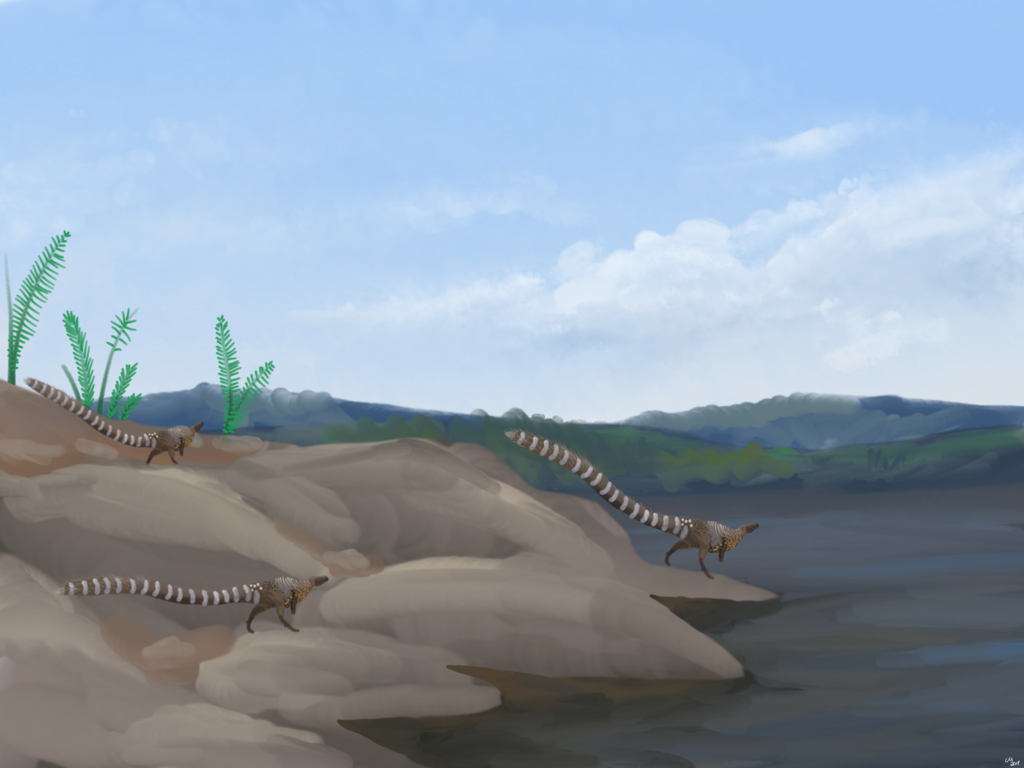In the rugged badlands of Montana, where wind-swept plains meet ancient rock formations, paleontologists in 1978 made a discovery that would revolutionize our understanding of dinosaur behavior. Maiasaura peeblesorum, whose name translates to “good mother lizard,” offered unprecedented insights into dinosaur parenting and social structure. This remarkable hadrosaur, which lived approximately 76 million years ago during the Late Cretaceous period, wasn’t just another prehistoric reptile—it was the first dinosaur to provide conclusive evidence of parental care. The discovery of Maiasaura nesting grounds containing fossils of eggs, hatchlings, juveniles, and adults painted a vivid picture of complex social behavior that challenged long-held assumptions about dinosaur intelligence and family life.
The Discovery That Changed Dinosaur Science
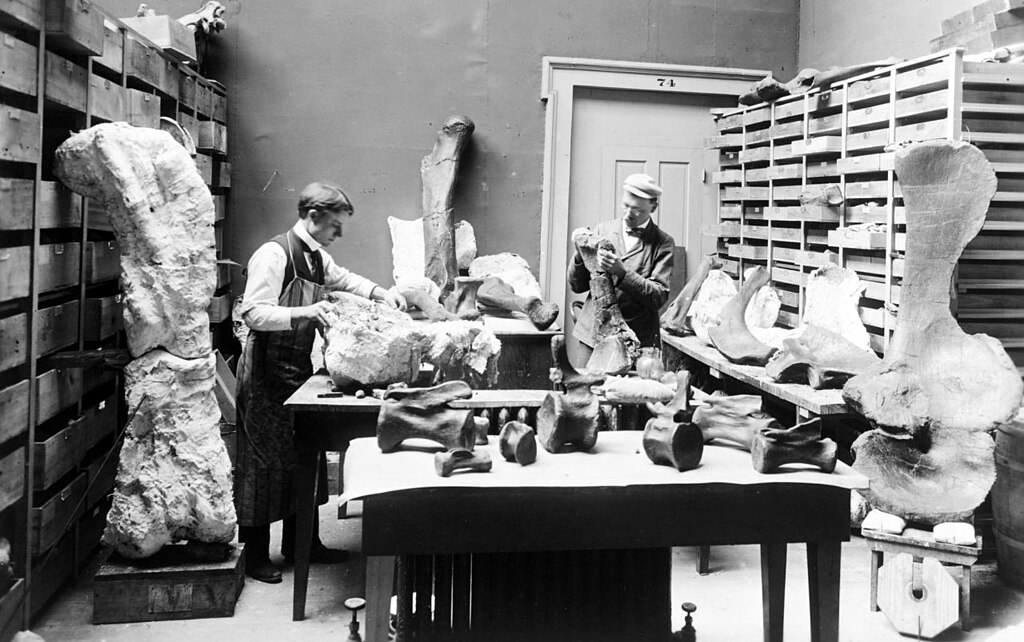
The story of Maiasaura begins in 1978 when paleontologist Jack Horner and his colleague Bob Makela discovered a vast nesting site in the Two Medicine Formation of western Montana. This extraordinary find included not just adult specimens, but also eggs, hatchlings, and juveniles of various ages—all preserved in what appeared to be a massive communal nesting ground. The site, later known as “Egg Mountain,” contained hundreds of nests arranged in a pattern suggesting these dinosaurs nested in colonies, much like many modern birds. This revolutionary discovery provided the first definitive evidence that at least some dinosaur species engaged in complex parental behaviors previously thought impossible for reptilian creatures. The fossils at this site were so well-preserved and numerous that they provided scientists with an unprecedented window into dinosaur life cycles and social organization, making Maiasaura one of the most important dinosaur discoveries of the 20th century.
The Meaning Behind the Name

The name Maiasaura peeblesorum carries deep significance that directly references the dinosaur’s groundbreaking place in paleontological history. “Maia” comes from Greek mythology, referring to a nurturing mother goddess, while “saura” means lizard. Together, the genus name “Maiasaura” translates to “good mother lizard,” explicitly acknowledging the evidence of parental care observed in the fossil record. The species name “peeblesorum” honors the Peebles family, who owned the land where the first specimens were discovered and supported the paleontological work. This thoughtfully chosen name broke with the tradition of naming dinosaurs after their physical characteristics or geographic locations, instead highlighting their behavior—a revolutionary concept at the time. The name has since become emblematic of the shifting paradigm in dinosaur science, which began viewing these ancient creatures not just as biological machines but as complex animals with sophisticated behaviors and social structures.
Physical Characteristics of the Good Mother
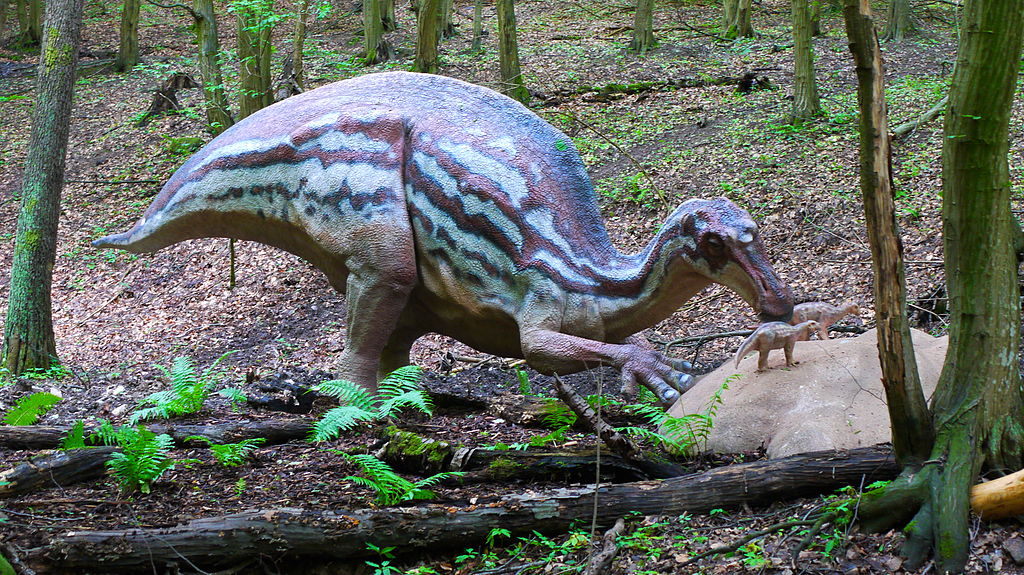
Maiasaura was a substantial hadrosaurid (duck-billed dinosaur) that exhibited impressive dimensions and distinctive anatomical features. Adults typically reached lengths of about 30 feet (9 meters) and stood approximately 7 feet (2.1 meters) tall at the hip, with a hefty weight estimated around 3-4 tons. Like other hadrosaurs, Maiasaura possessed the characteristic flattened, duck-like bill perfect for cropping vegetation, and hundreds of tightly-packed teeth designed for efficient grinding of plant material. Unlike some more elaborate hadrosaurs, Maiasaura had only a small, rounded crest on its skull rather than the dramatic hollow tubes or fan-shaped structures seen in relatives like Parasaurolophus or Lambeosaurus. The dinosaur moved primarily on its hind legs but could drop to all fours for stability or when feeding on low vegetation. Its powerful tail would have provided balance when walking bipedally and possibly served as a defensive weapon against predators. These physical traits made Maiasaura well-adapted to the lush, semi-tropical environment of Late Cretaceous Montana.
Montana’s Two Medicine Formation: The Ancient Nursery
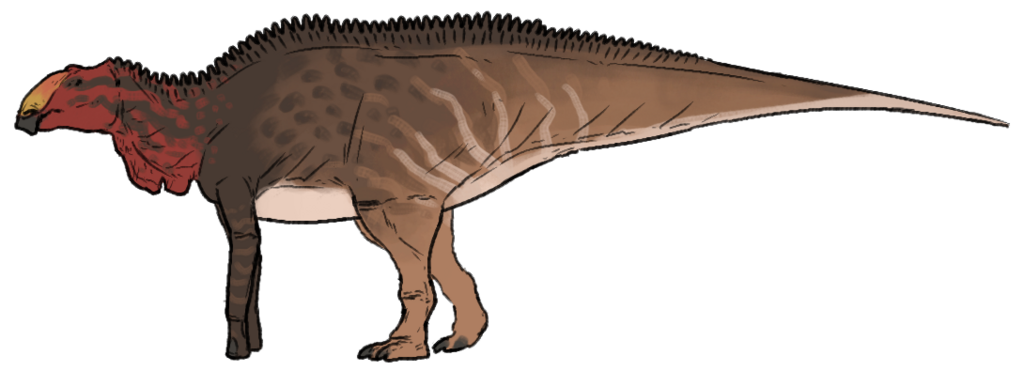
The Two Medicine Formation, where Maiasaura fossils were discovered, represents a geological time capsule preserving a 13-million-year slice of the Late Cretaceous period (approximately 83-70 million years ago). During Maiasaura’s time, this region looked nothing like the arid badlands we see today—it was a lush coastal plain situated near the western shore of the Western Interior Seaway, a vast inland sea that split North America in two. The climate was warmer and more humid than modern Montana, supporting rich vegetation including conifers, ferns, and flowering plants that would have provided ample food for herbivorous dinosaurs. Seasonal variations, including potential dry periods, influenced the ecology of the region and likely impacted Maiasaura’s nesting behaviors. The geological composition of the formation—primarily mudstone, sandstone, and volcanic ash—created ideal conditions for fossil preservation, particularly at sites like Egg Mountain. These unique preservation conditions allowed for the remarkable discovery of not just bones, but eggs, nests, and even microscopic details of embryonic and juvenile development that have proven invaluable to paleontologists.
Revolutionary Evidence of Parental Care
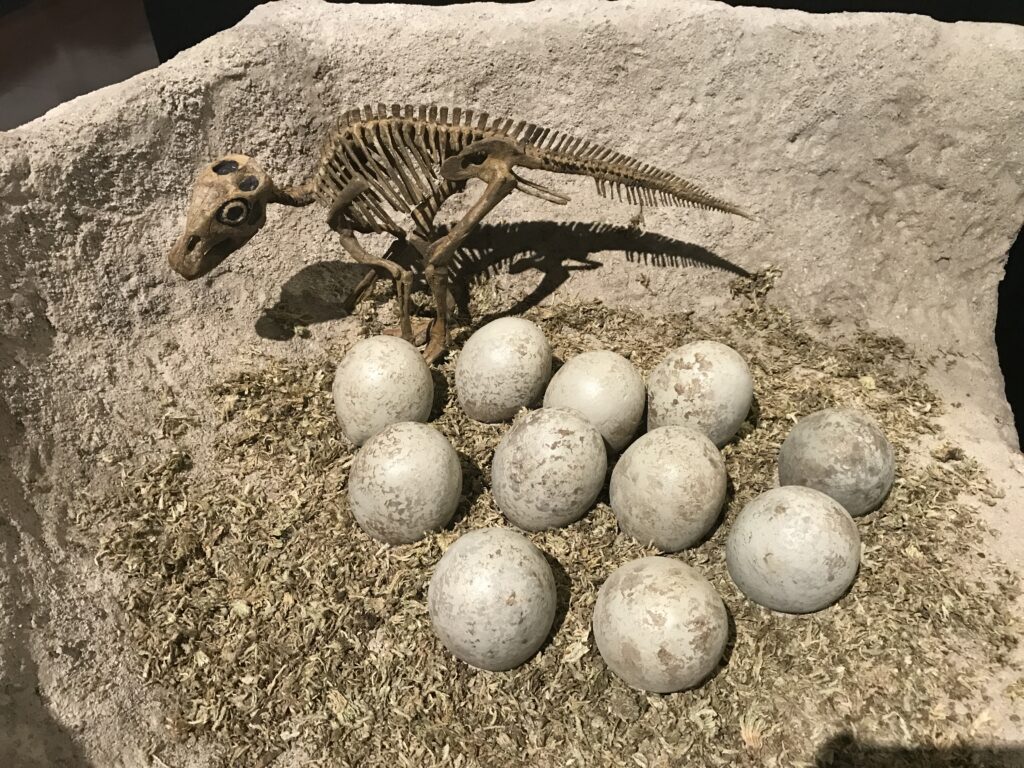
The fossils discovered at the Maiasaura nesting site provided unprecedented evidence that fundamentally changed our understanding of dinosaur behavior. Perhaps most compelling were the nests themselves—bowl-shaped depressions approximately seven feet in diameter with raised rims, spaced about 23 feet apart in a regular pattern suggesting colony nesting. Each nest contained between 30-40 eggs arranged in spiral patterns, with many nests showing evidence that the eggs were partially buried in rotting vegetation that would have helped incubate them. Analysis of the bones of hatchlings found in these nests revealed undeveloped leg bones, suggesting the babies were altricial—unable to leave the nest immediately after hatching. This contrasts sharply with modern reptiles, whose young are typically precocial (able to fend for themselves shortly after birth). Even more telling, the wear patterns on the teeth of hatchlings indicated they weren’t feeding themselves but were being fed processed plant matter by adults. The combination of colony nesting, nest construction, altricial young, and evidence of food provisioning created a revolutionary picture of dinosaurs as attentive parents, more similar to modern birds than reptiles in their reproductive strategies.
Life Cycle: From Egg to Adult

The exceptional preservation of Maiasaura specimens across various life stages has allowed paleontologists to reconstruct its life cycle with remarkable detail. The eggs, approximately the size of ostrich eggs, contained embryos that developed over a period estimated to be about 6-8 weeks before hatching. Newly hatched Maiasaura measured about 14 inches (35 cm) long and would remain in the nest for a considerable period, growing rapidly during this vulnerable stage. Studies of bone microstructure in juveniles revealed astonishing growth rates—young Maiasaura could grow from hatchling size to over 10 feet long in just a single year, gaining weight at a rate of approximately 2-4 pounds per day during peak growth phases. This rapid growth pattern suggests intensive parental feeding and care. By examining growth rings in fossilized bones (similar to tree rings), scientists determined that Maiasaura reached sexual maturity at approximately 3 years of age, though they continued growing for several more years before reaching full adult size. The estimated lifespan of a Maiasaura was likely between 8-12 years, considerably shorter than many modern large mammals but typical for dinosaurs of its size and type.
Colonial Nesting: Strength in Numbers

The arrangement of Maiasaura nests at Egg Mountain reveals a fascinating social strategy that mirrors behaviors seen in many modern birds. The nests were distributed in a remarkably consistent pattern—spaced approximately 23 feet (7 meters) apart, close enough for adults to maintain social contact but far enough to allow movement between nests without disruption. This spacing suggests a sophisticated understanding of territory and community structure. Conservative estimates indicate the original nesting colony contained hundreds of individuals nesting simultaneously, creating what would have been a bustling dinosaur nursery covering several acres. This colonial nesting behavior likely provided significant advantages in predator defense, as multiple adult Maiasaura could collectively watch for danger and potentially mob predators that threatened the colony. The social structure may have also facilitated cooperative feeding of young and possibly even sharing of parental duties among related individuals. The sheer scale of these nesting grounds, with hundreds of nests occupied over multiple breeding seasons, indicates Maiasaura lived in large, stable social groups that returned to the same nesting sites year after year—a level of social complexity previously unimagined in dinosaurs.
Diet and Feeding Habits

Maiasaura’s specialized dental equipment and digestive adaptations made it a highly efficient consumer of Cretaceous vegetation. Its broad, duck-like bill was perfect for cropping plants, while its dental battery—comprised of hundreds of tightly-packed teeth arranged in as many as 40 vertical rows—created an effective grinding surface that continually replaced worn teeth with fresh ones. This dental adaptation allowed Maiasaura to process tough plant material including conifers, ferns, and early flowering plants that dominated its environment. Paleobotanical evidence from the Two Medicine Formation suggests these dinosaurs likely fed on horsetails, cycads, ginkgoes, and various conifers that formed the understory of Cretaceous forests. Analysis of fossilized Maiasaura droppings (coprolites) has revealed partially digested plant material, confirming their herbivorous diet. Interestingly, these dinosaurs may have engaged in seasonal migrations following food availability, traveling between coastal lowlands and higher elevations as plant resources shifted throughout the year. The highly efficient digestive system of Maiasaura, combined with its sophisticated teeth, allowed these massive herbivores to extract sufficient nutrition from fibrous plant material to fuel their enormous bodies and rapid growth rates.
Predators and Survival Strategies

Despite their impressive size as adults, Maiasaura faced significant predation pressure in the Late Cretaceous ecosystem of Montana. The primary threats came from contemporary theropod dinosaurs, particularly Daspletosaurus (a tyrannosaurid relative of T. rex) and the smaller but numerous Troodon, both of which left telltale tooth marks on some Maiasaura fossils. The colonial nesting strategy likely evolved partly as a defense mechanism, as multiple adult Maiasaura could maintain vigilance and potentially coordinate defensive actions when predators approached the nesting grounds. Adult Maiasaura possessed powerful hind limbs capable of delivering dangerous kicks and could likely achieve running speeds of approximately 25 mph (40 km/h) in short bursts—sufficient to escape many predators. Their large size alone would have deterred all but the largest carnivores from attacking healthy adults. The most vulnerable periods in the Maiasaura life cycle were during hatching and early juvenile stages, which explains the intensive parental care observed in the fossil record. Evidence suggests that juvenile mortality was still high, with perhaps only 30-40% of hatchlings surviving to adulthood despite parental protection—a harsh reality of Mesozoic life that drove the evolution of Maiasaura’s reproductive strategy of producing numerous offspring in protected colonial settings.
Maiasaura’s Impact on Dinosaur Paleobiology
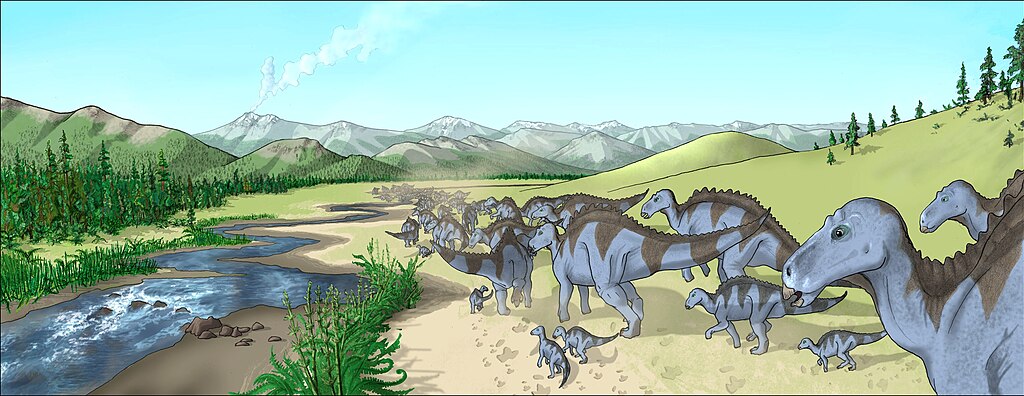
The discovery of Maiasaura fundamentally transformed scientific understanding of dinosaur biology, intelligence, and behavior in ways that continue to reverberate through paleontology today. Prior to these finds, dinosaurs were widely portrayed as solitary, cold-blooded reptiles with minimal parental care and limited social complexity—essentially oversized lizards. Maiasaura shattered this paradigm by providing irrefutable evidence of sophisticated reproductive strategies and social behaviors more reminiscent of birds than reptiles. This revelation supported the emerging theory of the evolutionary relationship between dinosaurs and birds, which has since become firmly established through multiple lines of evidence. The Maiasaura discoveries also prompted paleontologists to reexamine other dinosaur species for evidence of parental care and social behavior, leading to similar findings in other groups including sauropods, ceratopsians, and additional hadrosaurs. The “good mother lizard” effectively sparked the modern renaissance in dinosaur behavioral studies, inspiring new methodologies and research questions that have painted a much more nuanced picture of dinosaur life. Maiasaura remains a cornerstone example in discussions about dinosaur endothermy (warm-bloodedness), intelligence, and the evolution of parental care in archosaurs.
Cultural Impact and Public Fascination
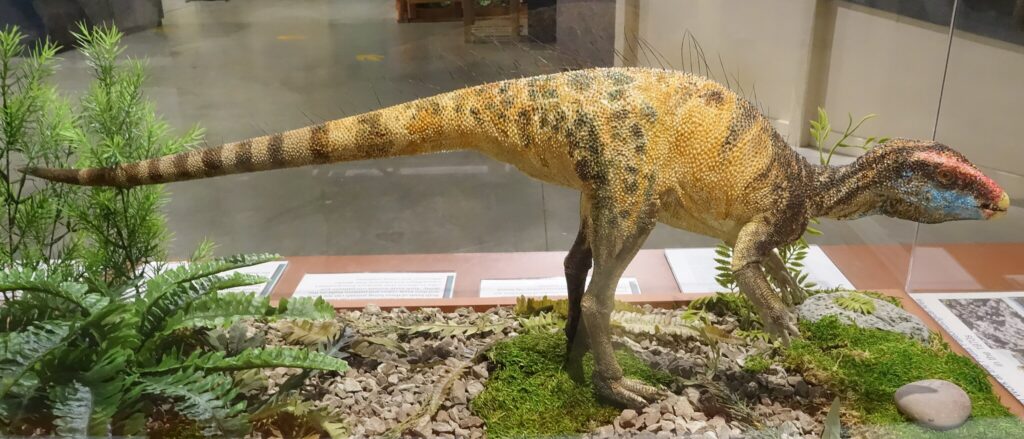
Maiasaura has secured a special place in popular culture as the dinosaur that changed our perception of these ancient creatures from cold-blooded monsters to caring parents. The discovery received extensive media coverage in the late 1970s and early 1980s, captivating public imagination with images of dinosaur mothers tending to nests of helpless babies—a strikingly mammal-like behavior that made these extinct animals suddenly more relatable. Children’s books, including the popular “Maia: A Dinosaur Grows Up,” have featured Maiasaura as a protagonist, using its life story to educate young readers about dinosaur science. The dinosaur has appeared in numerous documentaries, including PBS’s “Dinosaur Lives” and BBC’s “Walking with Dinosaurs,” typically portrayed emphasizing its maternal behavior. Montana officially designated Maiasaura as the state fossil in 1985, recognizing its scientific importance and connection to the state’s natural heritage. Museums around the world, particularly the Museum of the Rockies in Bozeman, Montana, feature Maiasaura exhibits that often focus on the nesting grounds and highlight the revolutionary aspects of its discovery. Through these cultural touchpoints, Maiasaura has helped transform public perception of dinosaurs from simple monsters to complex, behaviorally sophisticated creatures.
Jack Horner: The Paleontologist Behind the Discovery
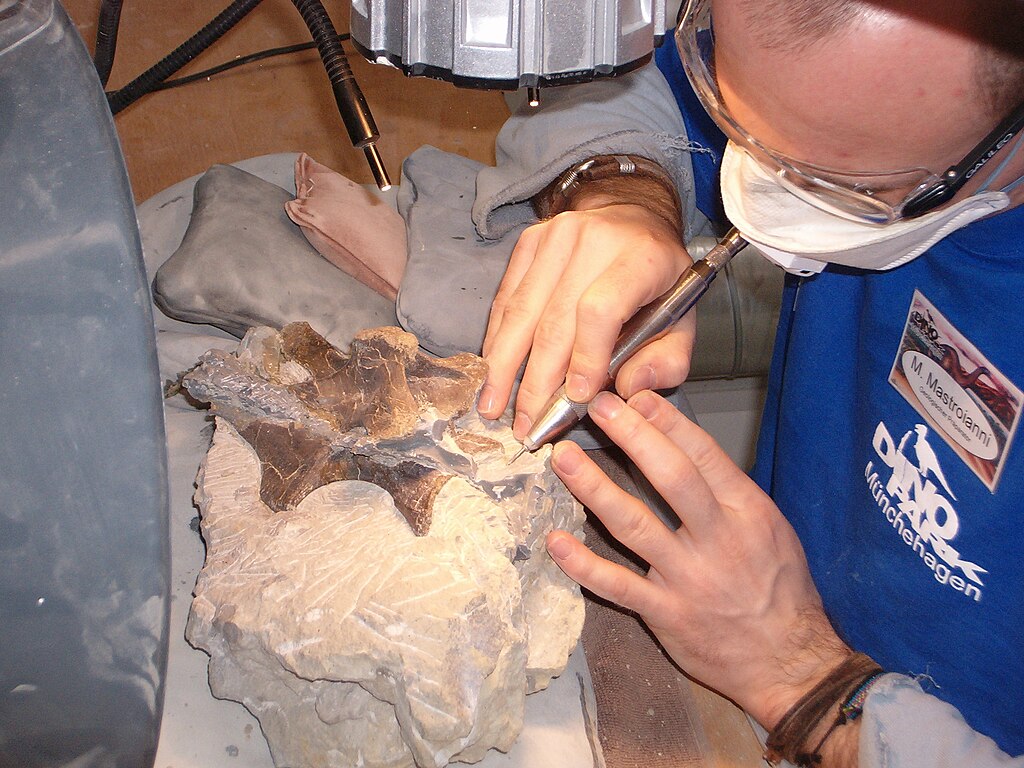
The discovery of Maiasaura is inextricably linked to paleontologist Jack Horner, whose unconventional career and research approach revolutionized dinosaur paleobiology. Unlike many of his contemporaries, Horner lacked formal advanced degrees but possessed an exceptional talent for fieldwork and a willingness to challenge established theories. After serving in the Marine Corps and working as a museum technician, Horner’s career took off with the Maiasaura discoveries at Egg Mountain in the late 1970s. His meticulous excavation techniques and focus on nesting sites—previously overlooked by many paleontologists—led to his groundbreaking insights about dinosaur parental care. Horner’s work on Maiasaura established him as a leading figure in paleontology and secured his position at the Museum of the Rockies, where he built one of the world’s finest dinosaur collections. Beyond his scientific contributions, Horner became well-known as the technical advisor for the Jurassic Park film franchise and as the inspiration for the character of Dr. Alan Grant. His dyslexia, which he has spoken about openly, presented challenges throughout his education but may have contributed to his visual-spatial abilities and unconventional thinking that proved so valuable in the field. Horner’s career trajectory and the Maiasaura discoveries illustrate how paradigm-shifting science often comes from researchers willing to question established dogma.
Ongoing Research and New Discoveries
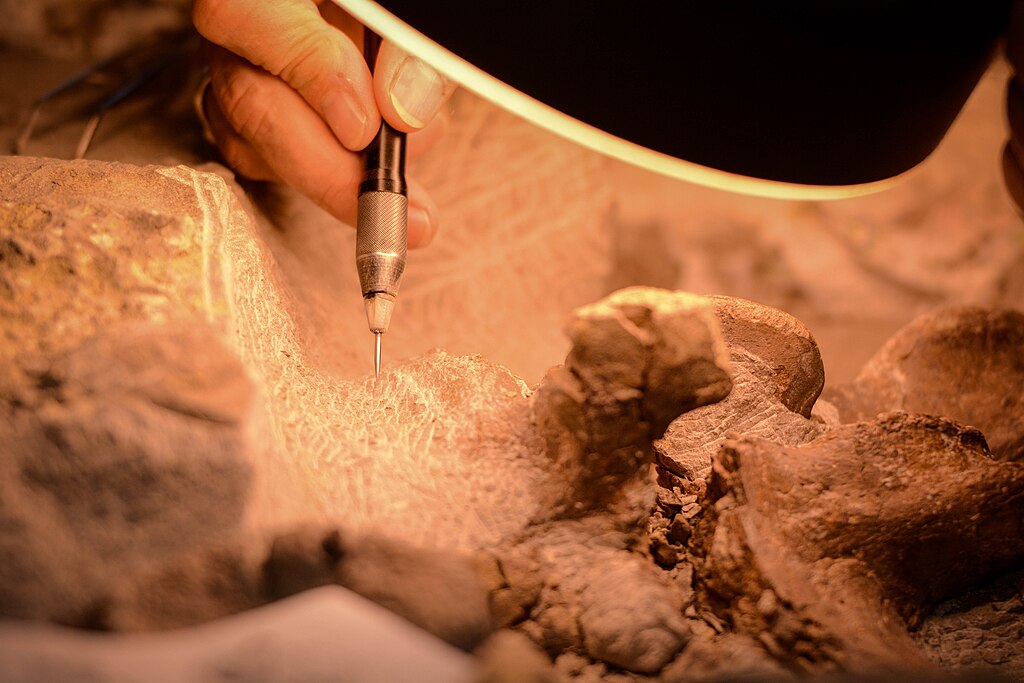
Though first discovered over four decades ago, Maiasaura continues to yield new scientific insights as advanced technologies and methodologies allow researchers to extract more information from existing specimens. Recent histological studies examining the microscopic structure of Maiasaura bones have provided detailed growth curves and metabolism estimates, suggesting these dinosaurs were mesothermic—maintaining body temperatures between those of modern reptiles and mammals. Isotopic analysis of tooth enamel has offered clues about seasonal migration patterns, indicating Maiasaura likely traveled between different elevations following food resources. New excavations in the Two Medicine Formation continue to uncover additional specimens, including a remarkable find in 2015 of multiple generations preserved together, further supporting theories about long-term social grouping. Advanced CT scanning of eggs and embryonic remains has revealed previously unobservable details about development, including brain case formation that suggests relatively advanced cognitive capabilities even before hatching. Paleontologists are also using modern ecological modeling to better understand Maiasaura’s role in its ecosystem, including estimates of population density and environmental impact. These ongoing studies demonstrate that even well-known dinosaur species continue to provide new information as our technological capabilities and theoretical frameworks evolve, ensuring Maiasaura will remain scientifically relevant for decades to come.




